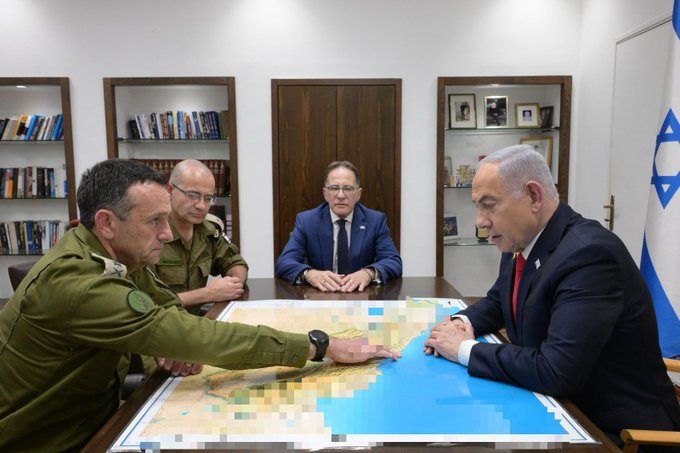Publications
INSS Insight No. 1898, October 10, 2024
As we mark one year since the war that began on October 7, 2023, it has become evident that Israel’s leadership sees only perpetual war on the horizon. This ongoing conflict benefits Israel’s enemies and aligns with Iran’s strategy of promoting a prolonged, multi-front war of attrition against Israel until its eventual collapse. So far, Israel has relied primarily on military and security measures without incorporating political strategies that could turn military successes into meaningful strategic change. Therefore, Israel’s leaders must shift from short-term tactical thinking to adopt diplomatic measures aimed at stabilizing the Gaza arena. Additional efforts should be made to advance a security-political arrangement with Lebanon, allowing northern residents to safely return to their homes. On the regional level, Israel should engage with the American proposal, backed by moderate Arab states, to form a regional coalition that would reduce Iran’s influence. Without such moves, Israel risks being dragged into a perpetual multi-arena attrition war that runs counter to its interests and capabilities.
Israel is currently marking one year since the war that began on October 7, 2023, characterized by multiple arenas (referred to by its enemies as “the unification of fronts”): the Gaza Strip, which had been the primary arena for the past 11 months; on September 19, 2024, Lebanon became the main arena, and Iran is likely next. Other arenas include the Red Sea, Judea and Samaria, Syria, and Iraq. Led by Iran, Israel’s enemies aim to destroy it through a continuous multi-arena war of attrition, while exploiting divisions in Israeli society and the loss of a shared sense of purpose. They use the Israeli–Palestinian conflict as a central argument to challenge Israel’s legitimacy.
This war may be the toughest chapter in Israel’s history since its founding. It is the longest war since the War of Independence and the most complex in terms of the damage and threats to the home front. Even a year after its onset, there is no plan for the release of the 101 hostages still held by Hamas in Gaza since October 7, 2023. The war continues without clear political goals or an exit strategy, as military efforts shift across fronts with varying intensity, while the public feels it will “forever live by the sword.” The overall trajectory points toward a prolonged regional war, with Israel moving rapidly toward widespread international isolation.
Thus far, the Israeli government has had difficulty formulating an exit strategy for both the Gaza and Lebanese fronts. Israel’s enemies in both arenas are sub-state actors driven by religious ideology who do not recognize Israel’s right to exist, making long-term political agreements difficult, if not impossible. Additionally, the international system has failed to function effectively. The lack of positive communication between the superpowers (the United States vs. Russia and China) has hindered efforts to impose a ceasefire and guarantee Israel’s security. Furthermore, Israel stands on the brink of direct conflict with Iran, its most powerful enemy, which has explicitly threatened that any extreme military action by Israel would compel it to develop military nuclear capabilities. Iran already possesses enough enriched uranium for several bombs, the knowledge to assemble a nuclear device, and missiles capable of carrying a nuclear warhead.

Nevertheless, Israel has rejected every initiative to end the war, including one presented by US President Joe Biden and others proposed by regional partners, peace-oriented nations, and pragmatic Arab states. Following a declaration by representatives of Arab states at the UN General Assembly, Jordanian Foreign Minister Ayman Safadi stated: “The Israeli prime minister came here today and said that Israel is surrounded by those who want to destroy it. We are here—members of the Muslim Arab committee, mandated by 57 Arab and Muslim countries—and I can tell you very unequivocally, all of us are willing to guarantee the security of Israel in the context of Israel ending the occupation and allowing for the emergence of a Palestinian state.” However, the current Israeli government views the creation of a Palestinian state as an existential threat to Israel. As a result, it continues its military confrontation in the Gaza Strip, preventing the Palestinian Authority from returning to control the area. It is also allowing anarchy to prevail in the West Bank, which could lead to the collapse of the Palestinian Authority—perceived as a threat because it serves as a potential foundation for the establishment of a Palestinian state. Additionally, Israel aims to destroy Hezbollah’s infrastructure in Lebanon and engage in an exchange of blows confrontation with Iran.
Israel’s actions in Gaza are leading toward the occupation of the Gaza Strip and the imposition of military rule. At the end of August, the security cabinet voted in favor of keeping IDF forces along the Philadelphi Corridor. Prime Minister Benjamin Netanyahu stated that the disaster of October 7 occurred because Israel did not control this corridor. He claimed that a significant flow of weapons through the corridor armed Gaza’s terrorist organizations, vowing that this situation “will not happen again.” Israel is now determined to maintain control over this border between the Gaza Strip and Egypt. As a result, the legal and practical responsibility for the Gaza Strip is likely to fall on Israel. Holding the corridor constitutes a complete siege of Gaza, reinforcing the argument that Gaza is effectively under Israeli occupation. This undermines Israel’s previous claim that Gaza was open to Egypt, thus relieving Israel of full responsibility for what happens there.
The practical consequences of this policy are significant: Israel will bear full responsibility for the two million Palestinians living in a disaster zone and will face ongoing terrorism and guerrilla warfare from Hamas remnants and other armed factions affiliated with the “axis of resistance.” The Israeli government has so far rejected any possibility of stabilizing and reshaping Gaza. It does not view the Palestinian Authority as a viable alternative to replace Hamas for control, and it has not worked to foster moderate local leadership. As a result, Hamas remains the de facto authority, controlling the distribution of humanitarian aid and shelter for most of Gaza’s residents.
Hamas’s continued existence and the holding of hostages serve as Israel’s main justification for continuing the war in Gaza and rejecting any ceasefire proposals. However, if the international community declares Gaza to be under Israeli occupation, no entity is likely to take over civilian and public order control. This would leave Israel with the Gaza problem for a prolonged period. Israel’s enemies would then gain further legitimacy to continue their attacks, the chances of returning the hostages as part of an arrangement would diminish, and terrorism and resistance from the Strip would persist. Iran and its proxies would likely escalate their attacks on Israel from multiple arenas. Pragmatic Arab states would have difficulties advancing normalization processes with Israel, let alone forming a regional coalition against Iran.
On the Lebanese arena, the Israeli government has not set a clear political objective and has even rejected a joint initiative by the United States and France for a temporary ceasefire and political arrangement that would push Hezbollah and other security threats away from Israel’s northern border. Past experience in Lebanon shows that security arrangements under international resolutions, such as UN Security Council Resolution 1701, have not effectively prevented the strengthening of terrorist elements near the border.
Nevertheless, Israel should not be blinded by the impressive achievement of eliminating Hezbollah’s leadership, including Hassan Nasrallah, and neutralizing its strategic capabilities. Israel must avoid being dragged into a prolonged war in Lebanon without clear political goals. Therefore, a mechanism to end the fighting must be formulated quickly, before Hezbollah recovers from its initial shock, shifts to a survival and attrition strategy, and the effectiveness of the IDF strikes diminishes. To prevent a return to a political arrangement that weakens over time, and to ensure lasting security and a sense of safety that will allow northern Israel residents to return home, Israel must enforce the terms of any arrangement with determination, using force when security arrangements are not upheld. This principle also applies to the Gaza Strip.
Concluding Comments
Israel’s traditional security doctrine emphasizes that it should aim for wars as short as possible due to its disadvantages in manpower, resources, and strategic depth. The goal is to strive for prolonged periods of calm, allowing the construction of the country, its development, and prosperity. However, Israel has not developed a security doctrine to address the challenges of perpetual multi-arena warfare, which has significant implications for the military, society, and economy, and has not yet been professionally examined.
Furthermore, contrary to the growing perception among the Israeli public that “we will forever live by the sword,” initiative and offensive actions should not be limited only to the battlefield but should also be pursued in the diplomatic arena. Israel has the opportunity to continue weakening the Iranian axis, which has suffered severe blows to its main proxies, Hezbollah and Hamas. At the same time, Israel can build a regional security and economic coalition with moderate Arab states. To achieve this, Israel must engage with diplomatic initiatives, particularly those led by the United States, and commit to progress toward a political process with the national/secular Palestinians—Fatah and the Palestinian Authority. This process should be supported by moderate Arab states and implemented through a multilateral approach to bridge the gaps and address constraints.



